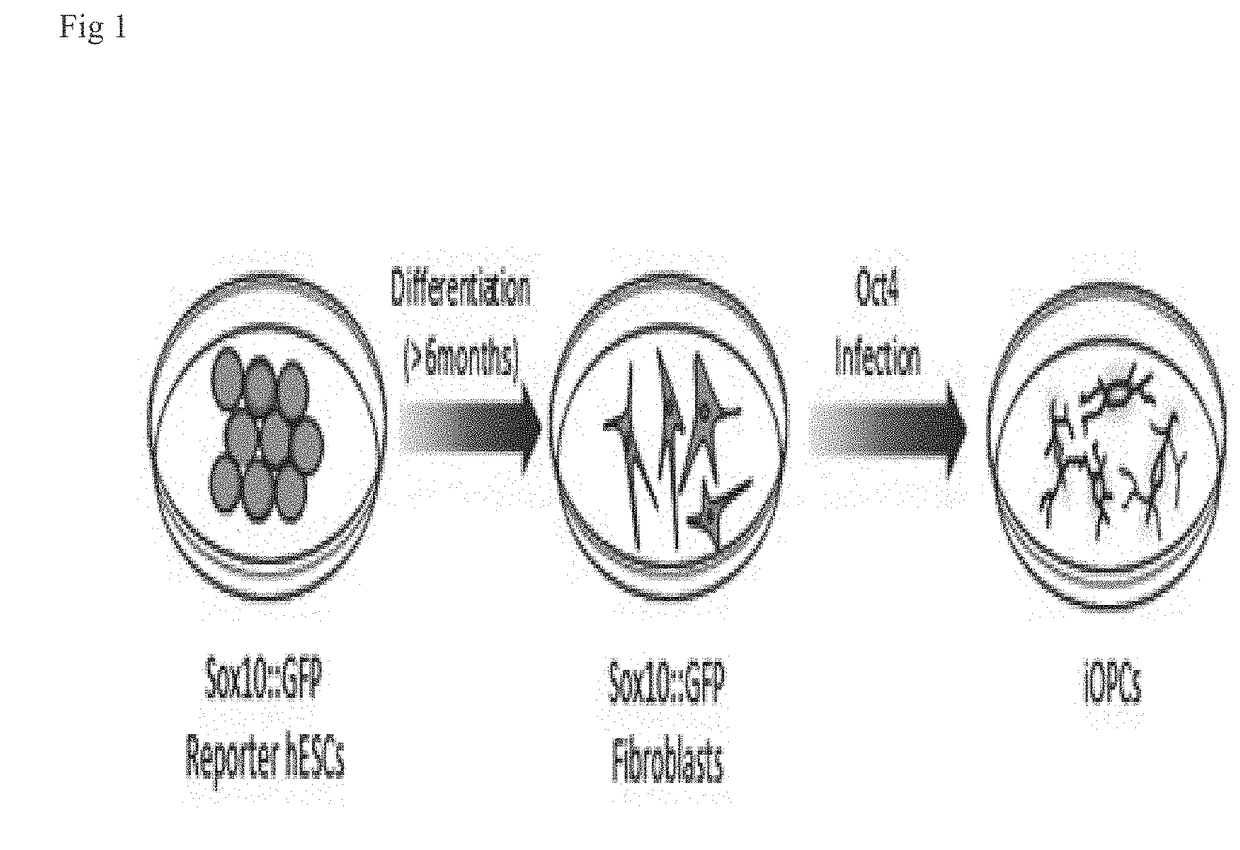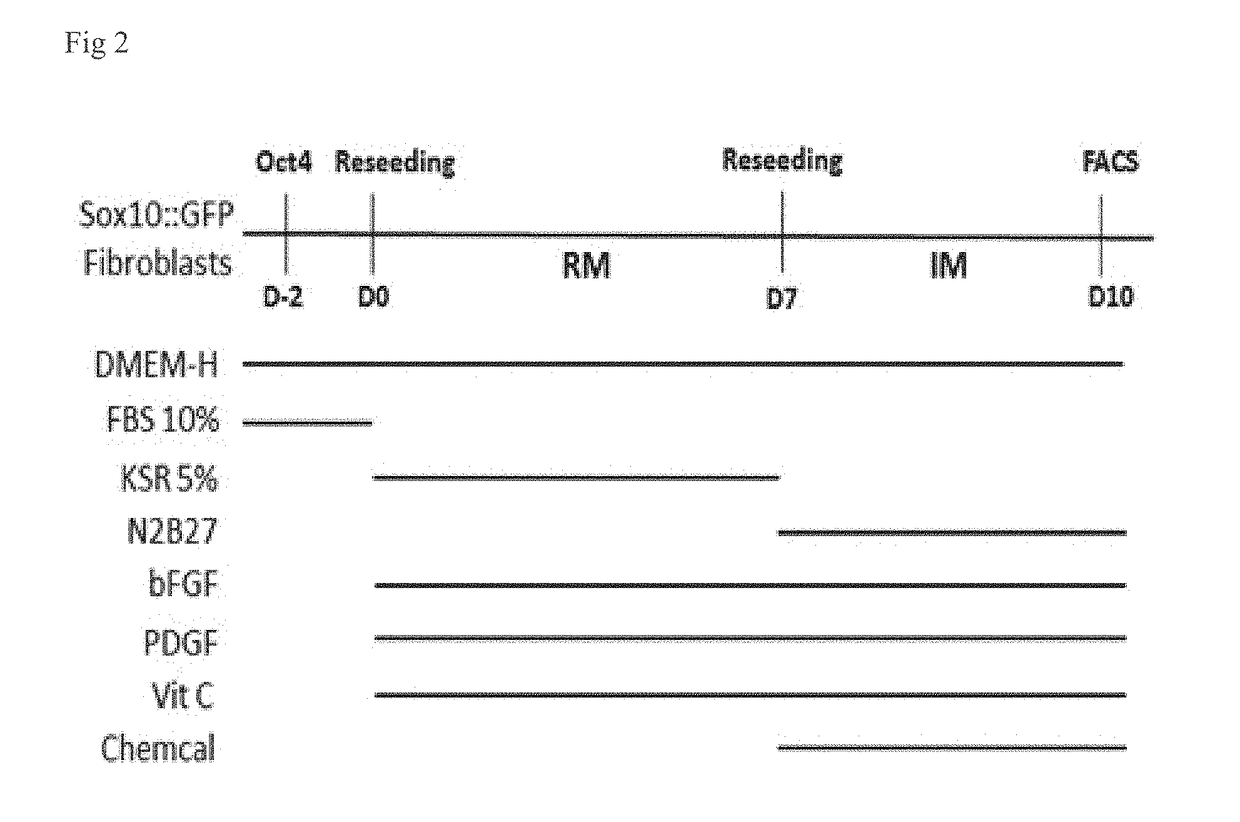Method for inducing oligodendrocyte precursor cells from oct4-induced human somatic cells through direct reprogramming
a technology of oligodendrocyte precursor cells and human somatic cells, which is applied in the field of inducing oligodendrocyte precursor cells, can solve the problems of low differentiation ability, no fundamental therapy, and ineffective nscs
- Summary
- Abstract
- Description
- Claims
- Application Information
AI Technical Summary
Benefits of technology
Problems solved by technology
Method used
Image
Examples
example 1
Selection of Low Molecular Weight Substance and Establishment of Induction Conditions
1-1: Selection of Low Molecular Weight Substance Using Sox10 Reporter System
[0072]The inventors have established conditions capable of inducing neural stem cells from mouse cells only with a low molecular weight substance without gene introduction (KR 10-1357402). Accordingly, to establish new conditions capable of inducing human somatic cells into OPCs on the basis of the low molecular weight substance that had been established in the previous study, a low molecular weight substance was selected using a Sox10 reporter system (Sox10::eGFP), which is a gene known to be important in development of oligodendrocytes (FIG. 1).
[0073]When Oct4 gene-introduced cells were cultured in a reprogramming medium (RM: DMEM with high Glucose+5% knock out serum replacement (KSR)+1% penicillin / streptomycin+1% non-essential amino acids+20 ng / ml basic FGF (bFGF)+20 ng / ml human recombinant platelet derived growth factor ...
example 2
Induction and Confirmation of OPCs from Human Somatic Cells
[0081]Since the Sox10::eGFP fibroblasts used as the reporter cell line of Example 1-1 are cells obtained through differentiation from embryonic stem cells (ES cells), other stem cells, excluding fibroblasts, may not be completely excluded, and thus it may not be seen as direct reprogramming from somatic cells. In addition, since a KSR-containing medium was used in the establishment of neural stem cells after Oct4 was overexpressed in human somatic cells by Shengding and Mickie Bhatia research teams in the United States, in this Example, to induce direct reprogramming from human somatic cells which are not derived from embryos without via neural stem cells, which are upper stem cells of the OPCs, a KSR-containing reprogramming medium (RM) was not used (FIG. 7).
[0082]That is, as a result of introducing an Oct4 gene into BJ cells, subculturing in a Matrigel-coated dish, and culturing for 4 days under induction conditions (IM) f...
example 3
Differentiation of OPCs into Oligodendrocytes
3-1: Differentiation into Oligodendrocytes
[0085]To confirm an ability to differentiate OPCs induced in Example 2 into oligodendrocytes, a growth factor was removed from a conventional medium, and the medium was replaced with a differentiation medium (DMEM with high glucose+1× N2+1× B27 (without vitamin A)+1% penicillin / streptomycin+1% non-essential amino acids+50 μg / ml ascorbic acid+40 ng / ml T3 (triiodo-1-thyronine)+0.5 μM thiazovivin+10 μM forskolin+10 ng / ml human leukemia inhibitor factor (LIF)).
[0086]As a result, a typical branch-type morphology of the oligodendrocyte was shown, and real-time PCR showed that MBP and MAG expression increased (FIG. 12).
[0087]In addition, as a result of co-culturing with neurons obtained from the hippocampus of a rat to confirm in vitro myelination by differentiated oligodendrocytes, it was confirmed that the neurons were myelinated by the differentiated oligodendrocytes (FIG. 13).
3-2: Confirmation of In ...
PUM
| Property | Measurement | Unit |
|---|---|---|
| molecular weight | aaaaa | aaaaa |
| morphology | aaaaa | aaaaa |
| concentration | aaaaa | aaaaa |
Abstract
Description
Claims
Application Information
 Login to View More
Login to View More - R&D
- Intellectual Property
- Life Sciences
- Materials
- Tech Scout
- Unparalleled Data Quality
- Higher Quality Content
- 60% Fewer Hallucinations
Browse by: Latest US Patents, China's latest patents, Technical Efficacy Thesaurus, Application Domain, Technology Topic, Popular Technical Reports.
© 2025 PatSnap. All rights reserved.Legal|Privacy policy|Modern Slavery Act Transparency Statement|Sitemap|About US| Contact US: help@patsnap.com



